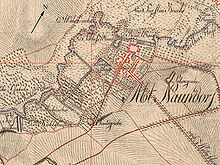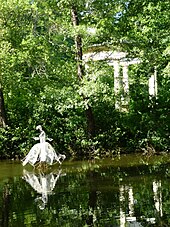Abtnaundorf
Abtnaundorf is a district of Leipzig in the northeast of the city. In terms of administration, it forms together with part of Schönefeld the district of Schönefeld-Abtnaundorf in the north-east district.
location
Abtnaundorf is about 4.5 kilometers from Leipzig city center in the floodplain of the Parthe . It is bordered by Schönefeld, Mockau and Thekla .
history
Naundorf was an old village with an estate , which came to the Peterskloster Merseburg in the 13th century and received the "abbot" in its name. The monastery leased the property several times, which then sometimes took the name of the lessee (Wognaundorff). The Vorwerk Heiterblick belonging to the estate was built around 1540 . After the Reformation , the estate changed hands frequently, and from 1696 it belonged to Johann Ernst Kregel von Sternbach for a long time . In 1789 it was finally acquired by Christian Gottlob Frege (1747–1816), the son of the banker Christian Gottlob Frege , and remained in the family's possession until 1916. As early as the middle of the 18th century, parts of the extensive landscape park between the village and the Parthe were laid out. In the Battle of Nations near Leipzig , Abtnaundorf was badly affected in the fighting on October 18, 1813.
At the beginning of the 19th century, the country house and villa development began, and after the Saxon rural community order came into force in 1838 , the first municipal council was elected in 1839. Until 1856 the place belonged to the electoral or royal Saxon district office of Leipzig . In the 19th century, Abtnaundorf, with its publicly accessible manor park, was a popular excursion destination for the people of Leipzig via the Parthew meadows. In 1892/93, under Arnold Woldemar von Frege-Weltzien, the manor on the estate was demolished and rebuilt as a palace (architect: Peter Dybwad ). In 1930 Abtnaundorf was incorporated into Leipzig.
In 1943 a satellite camp of the Buchenwald concentration camp was set up in Abtnaundorf , the inmates of which were forced to produce armaments in the Erla aircraft factory in Heiterblick. Before the approach of the American troops, the approximately 500 prisoners were driven on a death march in the direction of Wurzen. The remaining prisoners who were sick and unable to march were brutally murdered during the Abtnaundorf massacre (memorial on Theklaer Strasse).
In 1947 the manor became a municipal property and the castle was used for teacher training and as a hospital. From 1966 to 1996 the children's department of the St. Georg Hospital was here . Since 1998 the property has been developed into a comfortable residential complex by a private investor. From 2012, the apartments in Abtnaundorf Castle were divided into apartment and part ownership by a new owner.
The Nordost industrial park, which was developed from 1992 to 1995 (including VNG - Verbundnetz Gas , Ernst Klett Schulbuchverlag ), is largely located on the corridor of the former Abtnaundorf manor.
art
The installation “double light on dark banks” as part of the “KunstParcours und ParkNetzwerk Parthe” project is reminiscent of Clara Schumann .
Sports
The “ Egidius Braun ” sports school of the Saxon Football Association (SFV) is located in Abtnaundorf . It was built from 1958 to 1966. The eight hectare sports school grounds are home to the largest artificial turf hall in Germany with a size of 90 m × 60 m, two grass pitches, an artificial turf pitch with floodlights and a hotel.
The Steffi Graf Junior Center of the Saxon Tennis Association is located on the premises of the sports school .
The riding and driving club "Herodot" Leipzig e. V. holds riding and jumping tournaments every year.
literature
- Horst Riedel, Thomas Nabert (ed.): Stadtlexikon Leipzig from A to Z . 1st edition. Pro Leipzig, Leipzig 2005, ISBN 3-936508-03-8 .
- GA Poenicke (Ed.): Album of the manors and castles in the Kingdom of Saxony based on nature, newly recorded by F. Heise, Architect. I. Section: Leipziger Kreis. Leipzig, around 1860.
- Karl-Heinz Rother, Jelena Rother: The Erla-Werke GmbH and the massacre of Abtnaundorf , ed. from the Bund der Antifaschisten eV (BdA), seat of Leipzig / Leipzig city association of those persecuted by the Nazi regime (VVN) , 2013.
- Michael Liebmann, Schönefeld with Abtnaundorf, Neustadt and Neuschönefeld. A Leipzig district lexicon , ed. on behalf of Pro Leipzig e. V., 2019. ISBN 978-3-945027-33-2
- Greta Paulsen, Das Rittergut Abtnaundorf 1789–1916. "Pleasure for the eye, as for the mind for occupation" . In: Citizens, Gardens, Promenades. Leipzig garden culture in the 18th and 19th centuries , ed. by Nadja Horsch and Simone Tübbecke. Passage Verlag Leipzig, 2019, ISBN 978-3-95415-085-4 , pp. 219-224.
Web links
- Abtnaundorf in the Digital Historical Directory of Saxony
- Information website My district of the city of Leipzig for Schönefeld
- District in the Leipzig Lexicon
- Abtnaundorf . In: August Schumann : Complete State, Post and Newspaper Lexicon of Saxony. 1st volume. Schumann, Zwickau 1814, pp. 5-6.
- Herodotus riding and driving club
Individual evidence
- ^ Karlheinz Blaschke , Uwe Ulrich Jäschke : Kursächsischer Ämteratlas. Leipzig 2009, ISBN 978-3-937386-14-0 ; P. 60 f.
- ↑ Twice as bright on dark banks. In: Zweckverband Parthenaue. Retrieved February 3, 2020 .
Coordinates: 51 ° 22 ′ N , 12 ° 25 ′ E





